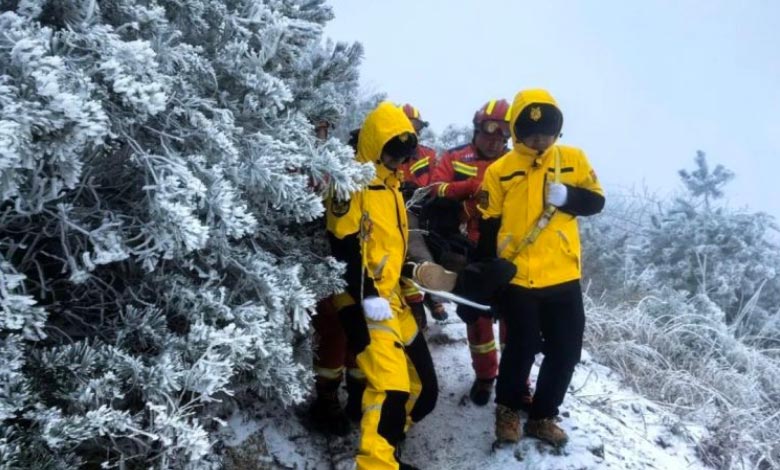Emergency rescue blanket is lightweight, compact and low cost, but do not generate heat, they only reflect the heat already present in the body. The self-heating blankets is their ability to actively provide heat, this means they go beyond simply “preventing heat loss” to “replenishing heat”, Self-heating blankets offer superior active warmth, crucial for combating hypothermia, especially when passive heat reflection isn’t enough.
In first aid, particularly in outdoor or extremely cold environments, maintaining body temperature is crucial. emergency rescue blankets (also known as space blankets or emergency blankets) and self-heating blankets are two common tools for warmth. They each have pros and cons, but self-heating blankets offer unique advantages in emergency applications.
Emergency rescue blanket
Advantages:
- Lightweight and Compact: emergency rescue blanket are incredibly light and can be folded into a very small size, making them easy to carry and store. They’re ideal for first-aid kits and outdoor gear.
- Low Cost: They are inexpensive to produce, making them suitable for widespread distribution and stockpiling.
- Blocks Heat Loss: Primarily works by reflecting up to 90% of the body’s radiant heat, effectively reducing heat loss from convection and evaporation. They also provide a barrier against wind and rain.
- Waterproof and Windproof: The material itself is waterproof and windproof, offering some protection in wet and cold conditions.
Disadvantages:
- No Active Heat Generation: emergency rescue blanket do not generate heat; they only reflect the heat already present in the body. If the patient is already hypothermic or unable to produce enough body heat, the warming effect of a Mylar blanket will be significantly limited.
- Poor Breath-ability, Prone to Condensation: The Mylar material is non-breathable, meaning body moisture will condense on the inside of the blanket. This can lead to dampness, which ironically might accelerate heat loss, especially during prolonged use.
- Easily Damaged: The material is thin and can tear or rip easily, reducing its protective function.
- Noisy: They can be noisy, producing crinkling sounds in the wind or when moved, which might disturb rest or reveal a location.
- Requires Body’s Own Heat Production: For weak, injured, or unconscious patients whose bodies have limited ability to generate heat, the effectiveness of a Mylar blanket is constrained.
Self-Heating Blanket
Self-heating blankets typically generate heat through a chemical reaction (like iron powder oxidation)
Advantages (Highlighting Key Benefits):
- Actively Provides Heat, Not Just Reflects: This is the most significant advantage of self-heating blankets. They actively release heat, providing a continuous external heat source even if the patient cannot generate enough body heat themselves (e.g., in cases of severe hypothermia, shock, or injury-induced metabolic slowdown). This is crucial for effectively raising and maintaining body temperature, preventing and treating hypothermia.
- Rapid Warming: Many self-heating blankets reach their operating temperature quickly, providing immediate warmth, which is critical in emergencies.
- Highly Independent: They do not rely on external power sources or the patient’s body heat production, functioning effectively in harsh conditions like the wilderness or during power outages.
- Long-Lasting: They typically provide stable heat for several hours or even longer, buying valuable time for rescue efforts.
- Increased Comfort: The active warmth provided by a self-heating blanket offers a far greater sense of comfort than the passive reflection of a Mylar blanket, significantly improving patient well-being and psychological comfort.
- Effective Against Conductive Heat Loss: While emergency rescue blanket cannot effectively prevent heat loss through conduction (e.g., contact with cold ground), self-heating blankets can actively generate heat to offset some of this conductive heat loss.
Disadvantages:
- Potentially Slightly Larger/Heavier: While compact versions exist, they are usually a bit heavier or bulkier than emergency rescue blanket.
- Single-Use: Most chemical reaction self-heating blankets are single-use products and cannot be reused.
In terms of first aid, emergency rescue blankets remain essential due to their lightweight, compact nature, and low cost, primarily serving to reflect body heat and offer protection from wind and rain. However, they cannot actively generate heat, limiting their effectiveness for already hypothermic or heat-producing impaired patients, and their poor breathability can lead to dampness.
The outstanding advantage of self-heating blankets is their ability to actively provide heat. This means they go beyond simply “preventing heat loss” to “replenishing heat.” In the following critical emergency scenarios, the benefits of self-heating blankets are particularly pronounced:
- Severe Hypothermia Patients: For individuals already suffering from severe hypothermia, the passive reflection of a Mylar blanket is insufficient to effectively raise core body temperature. Self-heating blankets can provide a continuous external heat source to help pull the patient out of danger.
- Shock or Severely Injured Patients: These patients may have impaired body heat production mechanisms and reduced metabolic rates. Self-heating blankets can offer crucial warming support.
- Extended Wait for Rescue: During long waits for professional rescue, a self-heating blanket can provide stable and prolonged warmth, significantly increasing the patient’s survival rate and comfort.
- Absence of Other Heat Sources: When it’s impossible to build a fire or there are no other warm clothes, a self-heating blanket can be the only direct source of heat.
Therefore, while emergency rescue blankets still have a place in basic first-aid kits, in more challenging emergency and survival environments, self-heating blankets offer significant advantages over emergency rescue blanket due to their active heat generation. They are a critical tool for transitioning a victim from merely “delaying heat loss” to “replenishing heat and increasing core body temperature.”



